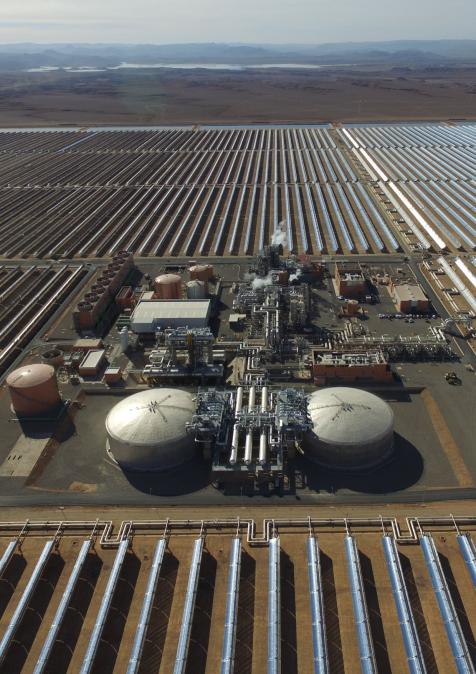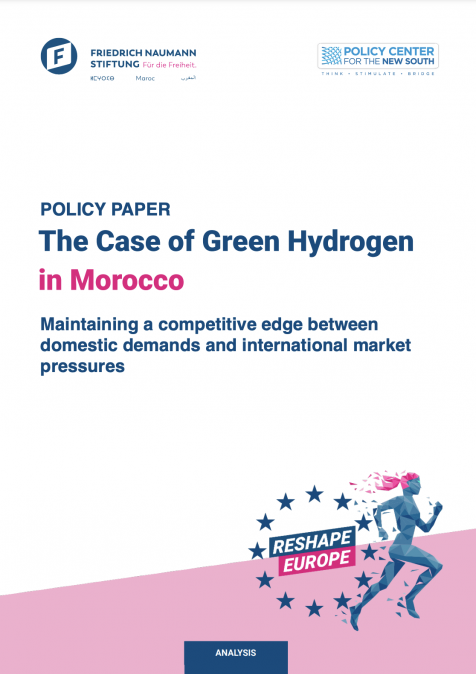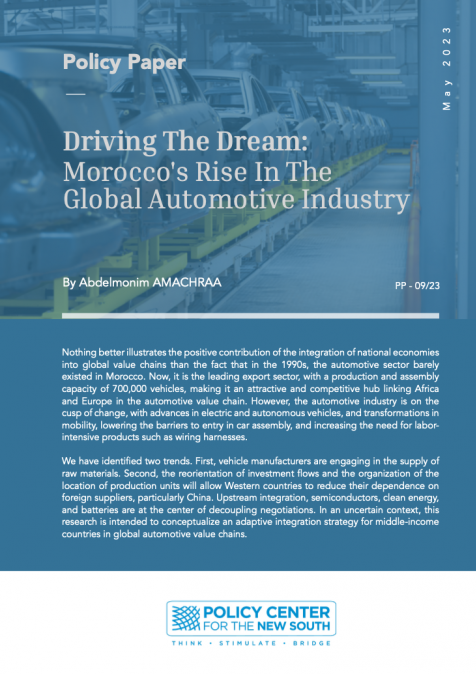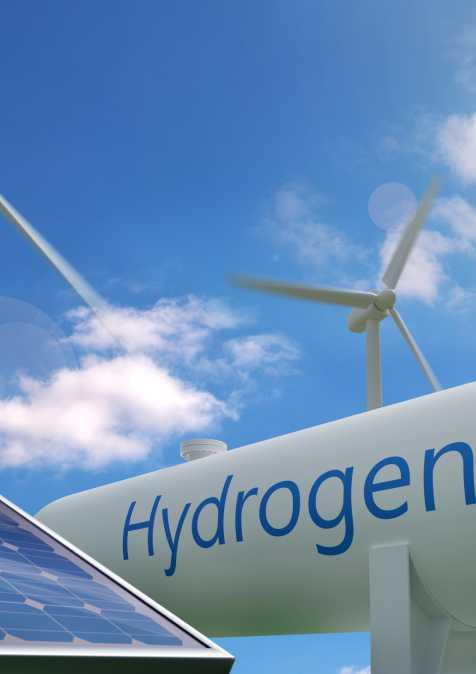Publications /
Opinion
As a net energy importer seeking to improve its energy security, Morocco has stepped up initiatives to achieve a level of domestic energy sovereignty. This includes following guidelines for transitioning to cleaner energy sources, with an emphasis on diversification. This diversification extends to natural gas, solar and wind power, and innovative solutions such as green hydrogen. Morocco recognizes cooperation as a crucial element for the success of its strategies, as underlined by the efforts made at COP28. By integrating these factors, Morocco is paving the way for a successful energy transition, without compromising energy security.
Morocco’s Natural Gas Strategy: A Bridge Fuel to Renewable Energy
Morocco’s decision to prioritize natural gas was not based solely on its transitional attributes but also took into account the opportunity costs. In fact, natural gas is favored because of its lower greenhouse gas (GHG) emissions compared to oil and coal (IEAa, 2023). The versatility of gas allows for easy storage, delivery through pipelines, or liquefaction for shipping. The adaptability of gas-fired power plants to quick on-and-off cycles makes natural gas a convenient solution for addressing both seasonal and short-term demand fluctuations (Tsafos, 2020).
However, Morocco relies heavily on natural gas imports, surpassing its domestic production levels. In 2020, domestic production stood at 3,473 terajoules (TJ), while imports soared to 28,194 TJ. The main consumer is the Office National de l'Electricité et de l'Eau Potable (ONEE), the national water and electricity utility, with a consumption of 884.3 million cubic meters (mcm), compared to 98.7 mcm for various industries, including the automotive, ceramic, mechanical and metallurgical, and pharmaceutical sectors (IEAb, 2023).
Morocco’s strategic focus on natural gas is articulated through a domestic roadmap, the Natural Gas roadmap that was launched in 2021 and covers the period 2021-2050,aims to create a regulated market that stimulates evolving demand. The roadmap envisions the development of essential gas infrastructure, ensuring access to competitive energy for industries and consumers. It also aims to enhance the competitiveness of Moroccan industrial exporters, while fostering ancillary subcontracting activities around the natural gas sector.
The roadmap unfolds in several steps, with the first phase involving the establishment of a regulatory framework for the natural gas sector. This includes the promulgation of draft laws, the extension of regulatory authority, and the creation of a Moroccan Natural Gas Transmission System Operator. The second step emphasizes assessment of demand dynamics, anticipating a surge in demand from industries shifting towards cleaner and competitive natural gas. This phase aligns Gas-to-Industry demand as a catalyst alongside Gas-to-Power to gradually replace coal. The third step focuses on evaluating the range of options for supplying natural gas (NG) and liquefied natural gas (LNG), exploring avenues including gas pipelines, floating storage and regasification units, onshore terminals, and multidirectional flows. This diversification plan aims to ensure flexibility in supply and guarantee regularity and continuity (mem.gov a, 2023).
The Natural Gas roadmap, currently under implementation, is guided by specific time objectives set by the Moroccan Ministry for Energy Transition and Sustainable Development. In the short term (up to 2025), the emphasis is on procurement, LNG, and onshore terminals. The medium-term phase (2020-2030) shifts the focus onto diversification of supply sources, with the Nigeria-Morocco Pipeline playing a central role. The long-term vision underscores the critical need for diversifying Natural Gas and LNG sources, as a risk-hedging mechanism, given Morocco’s heavy reliance on energy imports (90% of total energy). This strategic roadmap reflects Morocco's commitment to securing a sustainable and diversified energy future (mem.gov a, 2023).
Morocco’s Renewable Energy Potential, A Vision That Goes Back to 2009
Morocco has embarked on an ambitious journey to transform its energy sector. This ambition is driven by the High Royal Orientations and has three key pillars: increasing renewable energy capacity, promoting energy efficiency, and fostering regional integration.
The journey began in 2009 with the establishment of a comprehensive energy strategy, further broken down into roadmaps such as the Natural Gas roadmap, each outlining short, medium, and long-term objectives alongside legislative, regulatory, and institutional reforms. The initial phase, the National Plan for Priority Actions (PNAP), launched in 2009-2013, focused on restoring the balance between electricity supply and demand through increased production capacity (1400 MW) and rationalized energy use.
Recognizing the urgency of climate action, Morocco further scaled up its ambitions in 2015, setting a new target of a 52% renewable energy share by 2030, up from the initial 42% target. To achieve this, integrated programs were launched to install a staggering 6000 MW of renewable sources: 2000 MW each for wind, solar, and hydropower.
The initial phase yielded encouraging results, paving the way for this ambitious expansion. Key measures to support this growth include:
- Law 13-09: Opens the market for private-sector participation in renewable energy production and marketing.
- Law 37-16: Expands the Moroccan Agency for Solar Energy’s mandate to encompass all renewable sources.
- Law 48-15: Regulates the electricity sector and establishes a National Electricity Regulatory Authority.
Looking ahead, Morocco’s roadmap for 2019-2030 outlined the addition of 4262 MW of capacity, primarily from renewables (99.5%). This includes specific targets for wind, concentrated solar power, solar photovoltaic, and biomass energy. Additionally, the country aims to reduce greenhouse gas emissions by 42% by 2030 (17% unconditionally, 25% with international support).
By pursuing this ambitious clean energy transition, Morocco serves as an inspiring example of leadership and commitment to a sustainable future, demonstrating the potential of collaboration and innovation in addressing global climate challenges (Mem.gov b, 2023)
Green Hydrogen: A Lever for Morocco’s Energy Transition
Furthermore, Morocco introduced in 2021 its green hydrogen roadmap. The future potential of green hydrogen in Morocco involves optimistic scenarios for both domestic and international demand. Domestically, green hydrogen could be used as an input to industrial processes, especially in the fertilizer industry, and to a lesser extent as an alternative fuel in transportation, and for residential applications, and finally as a flexibility and storage solution for renewable energy. Externally, export demand is projected to represent 75% of the demand, and to reach 10.3 TWh by 2030 in the realistic scenario, and 21.7 TWh in the optimistic one, growing to 114 TWh and 229.5 TWh by 2050, respectively. Morocco’s strategic geographic position and maritime infrastructure are vital for hydrogen distribution. However, green hydrogen projects require collaboration between governments and the private sector, with suggested optimal financing structures emphasizing a mix of bank loans and green bonds to reduce risk and attract private investment (mem.gov c, 2023)
International Cooperation at the Heart of Morocco’s Energy Strategy
COP28 was also an opportunity to showcase Morocco’s advancement towards a just energy transition that leverages the power of collaboration. Among the key initiatives agreed during the conference in December 2023, Morocco and Ethiopia signed a Memorandum of Understanding to establish a Coalition for Sustainable Energy Access (CSEA), reflecting Morocco’s commitment to South-South cooperation for addressing climate change. The CSEA, an inclusive UN-recognized entity, aims to promote knowledge-sharing in sustainable energy, with its headquarters in Ethiopia (Maroc.ma, 2023). Additionally, the EU pledged €50 million to Morocco at COP28 to support green energy and carbon-removal initiatives, emphasizing collaborative efforts for sustainable development (Délégation de l’Union Européenne au Maroc, 2023). Finally, during the conference, several countries, including Morocco, issued a declaration that they would triple global nuclear energy capacity by 2050, recognizing its vital role in addressing climate change and achieving sustainable energy goals (Energy.gov, 2023).
Morocco is pursuing a resilient energy future through a multifaceted approach. This includes a strategic focus on renewable energy sources to accompany its energy transition, and the diversification of its energy mix to ensure a sustainable energy transition without compromising energy security. Securing investment and R&D are major challenges for achieving concrete results in terms of the energy transition, particularly for sources such as green hydrogen. It is important to address these challenges in order to successfully transition to cleaner energy sources. The global nuclear industry will also face challenges, including the cost of technology and public acceptance of this energy source. One thing is certain, strategic vision and diversification are key to reducing energy dependency and transitioning towards sustainable energy for net energy-importing countries like Morocco.
Bibliographic references:
IEA a ,2023, https://www.iea.org/energy-system/fossil-fuels/methane-abatement
Tsafos N.,2020, CSIS, ‘How will natural gas fare in the energy transition?’, https://www.csis.org/analysis/how-will-natural-gas-fare-energy-transition
IEA b, 2023, https://www.iea.org/countries/morocco
Mem.gov a , 2023, https://www.mem.gov.ma/Lists/Lst_rapports/Attachments/27/Feuille%20de%20route%20du%20gaz%20naturel%20au%20Maroc%20.pdf
Mem.gov b, 2023, https://www.mem.gov.ma/en/Pages/secteur.aspx?e=2
Mem.gov c, https://www.mem.gov.ma/Pages/secteur.aspx?e=2&prj=7
Maroc.ma, 2023, “COP28: Morocco, Ethiopia Join Forces to Create International Coalition for Sustainable Energy Access”, https://www.maroc.ma/en/news/cop28-morocco-ethiopia-join-forces-create-international-coalition-sustainable-energy-access
Délégation de l’Union européenne au Maroc, 2023, https://www.eeas.europa.eu/delegations/morocco/partenariat-vert-maroc-ue-un-nouveau-programme-d%E2%80%99appui-de-la-transition-verte-du-maroc-sign%C3%A9-%C3%A0-la_fr
Energy.gov, 2023, “At COP28, Countries Launch Declaration to Triple Nuclear Energy Capacity by 2050, Recognizing the Key Role of Nuclear Energy in Reaching Net Zero”, https://www.energy.gov/articles/cop28-countries-launch-declaration-triple-nuclear-energy-capacity-2050-recognizing-key








